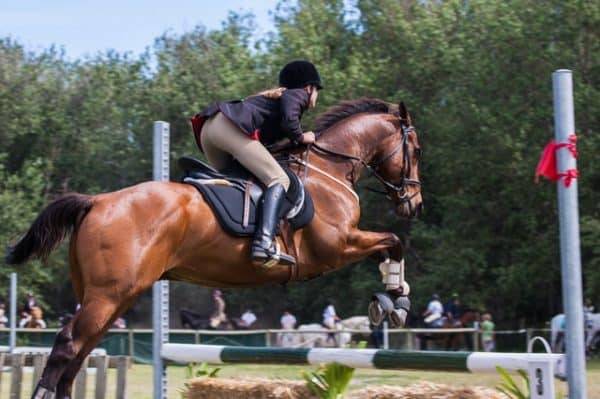So you want to learn about jumping on horseback! If you’re getting thinking about beginning to learn about horse jumping, there are some basics to get you started. Horse jumping is an extreme sport that takes not only advanced riding ability, but serious focus, body control, balance, and trust between you and your horse. Above all, horse jumping requires major confidence; not only must you have confidence in your connection with your horse but you must have confidence in your horse’s ability to make the jump. If your horse feels your nerves, it will make him or her nervous as well! Here are some basics about horse jumping to get you rolling.
Anatomy of a Jump
While there are a variety of jumps that include different elements, the most common type is a rail jump. A rail jump consists of three parts: the standards, rails, and jump cups. The standards make up the sides of the fence, the rails or poles create the cross bar, and the horse jump cups hold up the rails and can be adjusted up or down to raise or lower the jump. This ability to raise and lower the rails will be key as you learn to jump and continue to challenge yourself and your horse.
Prep for Horse Jumping
The first thing to begin practicing is the proper body position. A good position to begin with is called the two-point stance. It will be helpful to have an instructor or teacher show you this position, but the basic idea is to be in a position that absorbs the motion of the jump. You achieve this by being up on the balls of your feet with your knees bent. You will be forward over the front of the horse, but without putting pressure on the horse’s neck; all the balance is in your feet. Practice this position at a walk, a trot, and a canter, without going over an jumps, just to get use to the feel.
Beginning Steps of Jumping
After you’ve gotten comfortable with the position, lay down some ground poles and begin walking, trotting, and cantering over those in both normal and two-point positions. Once you feel competent here, begin working with a cavaletti, which is a slightly raised pole that will give you the feel of a jump. Take this pole at a trot and canter until you start to feel that jumping motion, and soon you’ll be ready to take on small jumps.
Horse jumping requires a lot of strength, confidence, and practice, but the good news is, when you know how to begin, you’ll be on your way to jumping fences in no time.





